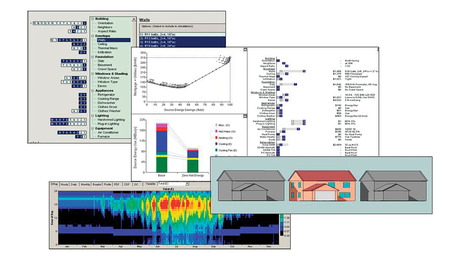Managing Job-Site Conflict
Hard conversations are unavoidable, but they can be done well.

Job-site conflict is an inevitable reality during the life cycle of a construction project. Conflicts can and will happen between all the parties involved in the outcome of the job: between crew members and bosses, between builders and architects, between subcontractors and general contractors, and between clients and pretty much everyone else.
These situations arise because of several factors, including personal differences, power struggles, conflicting concerns, and miscommunication. I’ve written before on how to set up projects for success from the start and avoid some of these disagreements altogether (see “Best Practices for Home-Building Project Communication”).
But a perfect project doesn’t exist, and when conflicts are left unresolved, the results can lead to significant problems— including no-show trade partners, an unhappy build team, disappointed design teams, and, most importantly, an unhappy homeowner. Fortunately, there are tools and techniques for handling these situations and getting things back on track.
Identifying common conflict types
I think we can all agree that no matter the situation, there are some people with whom it’s not so easy to get along. Personal differences can cause uncomfortable tension in any circumstance, but this is especially the case in the potentially close quarters of a remodel or a new construction project, where the stakes can be high. Communication styles, different work ethics or opinions on best practices, or non-work-related issues such as personal beliefs or political views can create a conflict-ridden work environment, whether explicitly acknowledged or not.
Power struggles can also be a problem. The team that is assembled on a construction project is not always a dream team or a group whose members have chosen to work together. Sometimes the circumstances of budget, location, or availability are the main factors determining who is on the team. Who the person in charge of a project is may not be clearly defined, which can lead to power struggles. In some cases, the architect is running the show; at other times, the builder is the lead. In many cases, although the homeowner hired professionals to run the project, the homeowner ends up steering the ship.
Conflicting concerns or competing interests can frequently create job-site conflict. In seemingly harmless instances, it may be two or more trade partners competing for the same space to do their respective tasks or positioning for power outlets or convenient parking spaces at the job site. A moment of concern turns serious, however, when someone’s desire for speed compromises safety. In this moment the conflict must be addressed immediately, and a safe work environment must be maintained.
One of the most common causes of conflict is miscommunication. Occasionally there are discrepancies in the drawings or specifications; different parties are therefore left to interpret them and may do so differently. Often it’s the common vocabulary that can be the problem. One person’s soffit is another person’s eave.
A diverse workforce—while beneficial in many ways—also brings with it the potential for miscommunication such as when navigating language differences. From the builder’s perspective, conflict often arises from not managing the client’s expectations on issues that seem routine or insignificant to the builder, such as noise, schedule, or when decisions need to be made.
Having the hard conversation
Despite the issues that will undoubtedly come up, proper communication that emphasizes opening up a dialogue can remedy the situation. Listening thoughtfully, creating an environment for discussions to happen, and, if necessary, involving mediation or even terminating the relationship are all communication tactics that can be used in their appropriate contexts.
First, it’s best to listen to understand rather than to listen to respond. Listening to understand and not just to be heard is not a natural skill of mine. I’ve worked hard to develop it, and although I am not perfect at it, this ever-evolving skill has been helpful when I have had to engage in difficult conversations. A clear response is needed and often expected; however, it is important to give yourself a chance to process thoughtfully the point the other person is trying to make. A moment to reflect or give some virtual space may in fact change the dynamic of the conversation and potentially the outcome. Allowing space for silence after the other person has finished speaking may also offer an opportunity for that person to reflect on the point they made and maybe even realize that they are the one in error. It is not easy to admit when you are wrong, but being listened to intentionally may provide an opportunity for some internal consideration and some comfort in knowing that being wrong is OK. People who feel that have been genuinely heard are more likely to respond favorably to your influence and point of view.
In addition to getting comfortable with moments of silence, it is important to be engaged sincerely with the person having a conversation with you. Ignore your phone, the noise from the job site, and any other potential distractions that could lead to the perception that you are uninterested in the conversation. It’s probably best to find a spot away from any commotion and to have they an “indoor voice” conversation while looking the person in the eye. It’s true what they say: Cooler heads prevail.
It can be easy to avoid engaging in conflict, but bad news does not get better with time. Avoiding a hard conversation today is a sure way to have a harder one in the future, because inevitably the issue will come back to haunt you if it is not addressed in a timely manner. The best time to address any problem with the homeowner, architect, tradesperson, or partner is yesterday—and the next best time is now.
Job sites can have a reputation for not being “holy ground,” so to speak. It is up to us to change that stereotype and live out the values we wish to create by establishing conditions that are welcoming and inclusive. This not only helps mitigate some types of conflict that come up, such as discrimination based on gender or race, but it can also set the conditions for respectfully navigating disagreements when they do come up. Creating an environment for open dialogue is essential and will help to ensure that this happens. Formally or informally, and without consequence or retaliation, have a process for people on the job site to speak openly about issues that concern them. In your daily or weekly meeting, allow time for folks to share their concerns.
In a tense or delicate situation, it is important that the team knows they can also approach you privately. I’ve found that the best way to build this environment involves food. Some of the best conversations I’ve had on job sites have happened while I was sitting on an upside-down compound bucket eating a sandwich. If you bring donuts and coffee, somehow people will find a way to relax a little and have a hard conversation.
Documenting conflict
It may not seem significant in the moment, but I advise writing down the details of conversations you have about job-site conflict, especially with your staff but also with trade partners, the design team, and homeowners. The obvious reason for doing this in a formal way is to document any potential human resources issues that result in employee termination. But documenting and tracking conflicts can also help you and your whole team identify patterns of conflict, including who is involved, when these incidents happen, and what may have caused the situation. When tensions get out of hand quickly, it can be tough to establish the root cause. Recording disagreements can help to isolate the issue, allowing you to avoid or resolve problems before they escalate. It can also help you to see how each problem was resolved, providing insight into how conflicts can be avoided or at least lessened in the future.
Ending the relationship
There is a chance that the roots of a potential or actual conflict will run deep and that despite your best efforts, avoiding it or resolving it will be beyond your capabilities. In that case, a professional mediator might be the best solution, especially if you are trying to salvage a project or, just as important, a relationship. The reality is that some relationships with an employee, trade partner, architect, or homeowner are difficult to maintain. There may in fact be times when it is advisable to go separate ways, as difficult as that may seem at the time. If you decide there is no other way forward, then that is the time to terminate the relationship.
To address this potentiality ahead of time, include terms in your contract that spell out the mediation process, and make sure you get advice from your lawyer and another essential member of your team.
Not all conflict is bad
Finally, it’s important to note that sometimes conflict can be a good thing. Just as the abrasive nature of sandpaper leads to smooth surfaces, the sometimes-harsh landscape of disagreement and incongruity can lead to beautiful things. Every so often, the strain of conflict results in wonderful and creative outcomes.
Greg Woleck is a project management consultant at HELM Construction Solutions in Brattleboro, Vt.
From Fine Homebuilding Issue #317
Photo by mrmohock on Adobe
RELATED STORIES
- How to Hire and Retain Good Tradespeople
- 6 Rules for Quality, Safe, and Efficient Labor
- Gender Bias: Stopping the Cycle in Architecture
Fine Homebuilding Recommended Products
Fine Homebuilding receives a commission for items purchased through links on this site, including Amazon Associates and other affiliate advertising programs.

Affordable IR Camera

8067 All-Weather Flashing Tape

Reliable Crimp Connectors


























